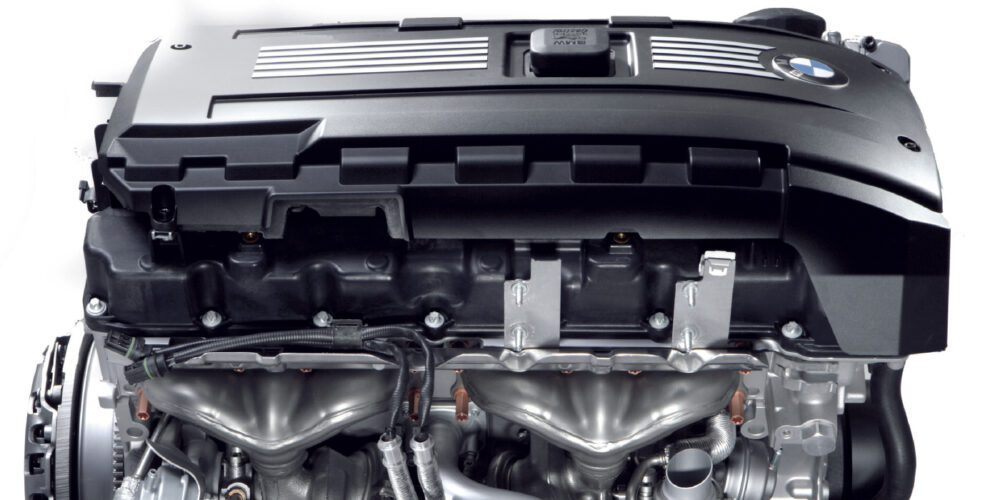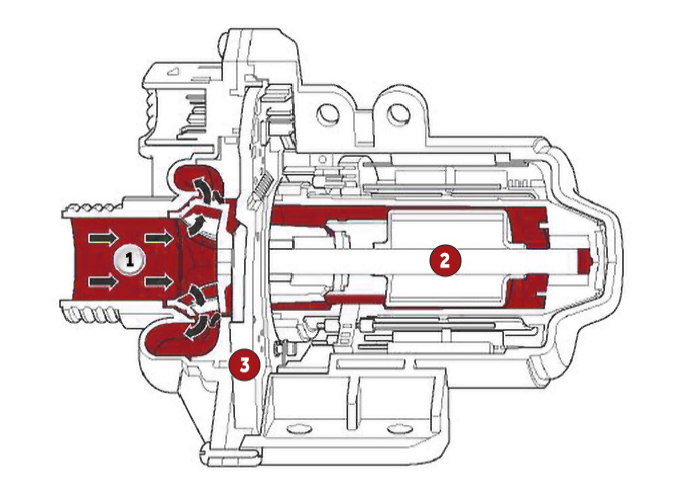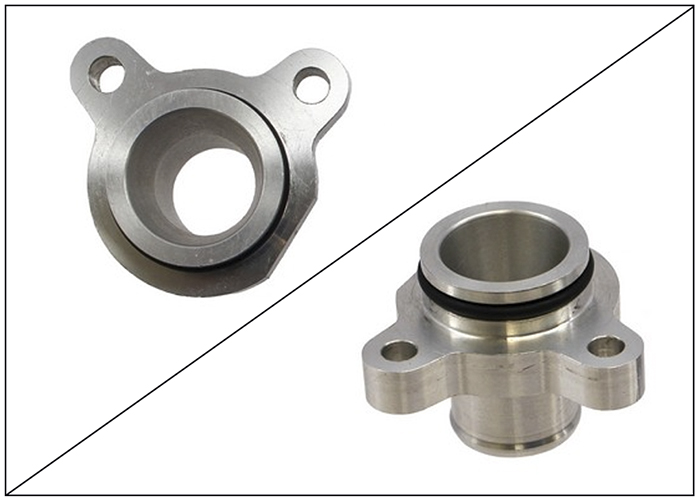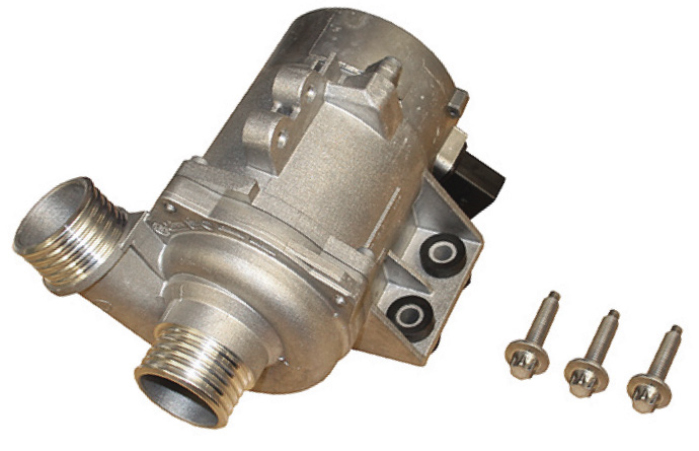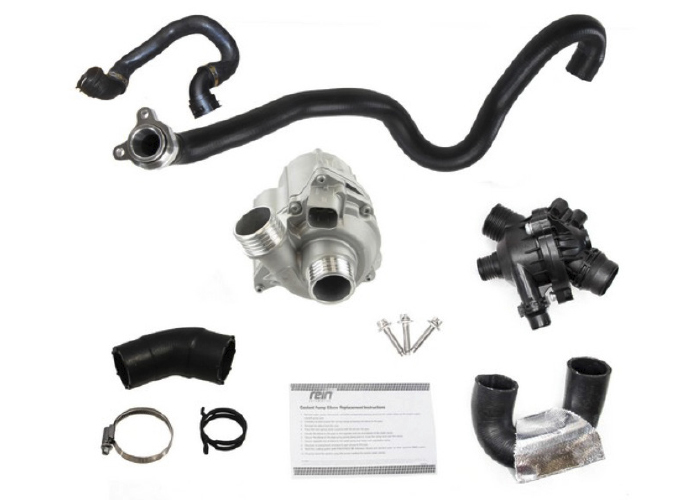The BMW N54 is known for its smooth power delivery, nearly nonexistent turbo lag, and robust forged internals. It’s also known to suffer from a few common issues, one of which is its electric water pump. That’s right, the water pump, the component that circulates coolant throughout the engine cooling circuit, is electric. There’s no direct connection between the engine and the pump, which does offer some unique benefits, but we’ll get into that a bit later on.
The water pumps we’re discussing are used in a number of vehicles. This includes the 128i, 325i, 325xi, 330i, 330xi, 525i, 525xi, 528i, 528xi, 530i, 530xi, X3, X5, and Z4. Let’s take a closer look at this unique water pump, how to replace it efficiently, and what other components should be replaced along with it.
Why Electric?
Electric water pumps are becoming more and more common on modern engines. Electric auxiliary water pumps have been around for a long time. Their job is to circulate warm coolant through the heater core or to circulate coolant throughout an additional cooling circuit, such as a water-to-air charge air cooler.
But, what happens when the main water pump goes electric? Using an electric water pump instead of the more common belt- or chain-driven mechanical pump does offer a number of advantages to both automakers and customers. The speed of a mechanical pump is directly tied to engine RPM, so the pump is only able to circulate coolant at a given rate. But since there is no mechanical link between the engine and the electric water pump, it is able to circulate coolant at whatever rate is needed based on operating conditions. This allows for a lot of flexibility when it comes to thermal control, and it gives BMW the ability to more precisely control underhood temperatures and emissions.
The electric water pump (#1 in Figure 1) on the N54 has a power output of 400W, and a maximum flow rate of 9,000 liters per hour. The motor (#2 in Figure 1) power is electronically controlled by the control module (#3 in Figure 1) inside the pump housing, and this module is connected via the communication BUS to the Digital Motor Electrics (DME), also known as the engine control unit or ECU. The DME uses the engine load, the operating mode, and the data from the temperature sensors to calculate the required cooling output, then commands the electric pump according to the current operating conditions. The electric pump regulates its speed based on this command from the DME. Coolant flows through the motor inside the pump, providing cooling to both the motor and the electronic module.
The electric water pump circulates coolant even after the engine has been shut off. Doing this can cool down the turbochargers and help to prolong their service life. The pump can be positioned anywhere in the engine bay since it no longer relies upon the belt drive. This gives BMW some flexibility in where it chooses to mount the pump, and allows it to optimize the coolant distribution circuits to fit its needs. And, finally, engine efficiency is increased (albeit ever so slightly) thanks to the reduction in engine load. The bottom line is that fewer rotating assemblies means less load on the engine, and better fuel economy. We’re not talking about a lot here, but it’s enough for automakers to qualify for certain tax incentives, or to help their entire lineup comply with regulations and avoid penalties.
There is one tradeoff for all of these benefits: service life. Mechanical water pumps tend to last a long time, provided that the vehicle is maintained well and there are no outside factors at play. Electric water pumps on the N54 have been known to fail around 60,000-80,000 miles.
When the DME detects an issue with the pump, or if it sees engine coolant temps rising, it will notify the driver through the instrument cluster. This may take the form of one of two different messages: “Engine Temp High – Drive Moderately” displayed in yellow, or “Engine Overheat – Stop” displayed in red. The vehicle may go into “limp mode” which limits the engine RPM and available gear selection in an effort to protect engine components from damage. The electric cooling fan will usually jump to its maximum speed, and it will be loud! You may also find stored 2E81 and/or 2E82 trouble codes which indicate a problem with the pump.
Related Issues
The water pump and the thermostat should always be replaced at the same time. These two components are literally bolted together, and it simply doesn’t make sense to replace one without the other. We’re talking about a pretty labor intensive job, so replacing them both together could save another costly repair down the road.
There are two other cooling system issues you should be on the lookout for whenever you’re inspecting or quoting a replacement to a customer: The coolant inlet pipe, and the “Mickey Mouse” hose.
The coolant inlet pipe is an aluminum pipe with a rubber elbow on one end and an aluminum flange on the other end. The aluminum flange bolts up to the cylinder head between the turbochargers, and the rubber elbow connects to the water pump. The aluminum portion of this component should last for a long, long time, but the rubber elbow is prone to failing. This is largely due to the fact that it is mounted so close to the front turbocharger.
The real issue for customers is that BMW offers only the entire assembly; the hose isn’t available from the dealer separately. The hose clamp on the water pump side is a standard worm-drive unit so it’s easy to remove, but the other clamp is proprietary and it’s extremely difficult to remove without cutting it off. Worst of all, the flanged end of the pipe is tucked between the turbochargers, behind a number of heat shields and the downpipes.
All in all, it’ll take 6.7+ hours to replace this pipe, which feels like a waste if the rubber elbow is the only part that really failed. Thankfully, Rein offers the hose by itself, and it should take only an hour to install. I would strongly urge you to consider selling this replacement part whenever the water pump is being replaced. Call it peace of mind, call it preventive maintenance – either way it makes a lot of sense for you and your customers.
One of the many hoses which connects to the thermostat and water pump connects to the front of the engine just under the valve cover. This hose is commonly referred to as the “Mickey Mouse hose” due to the unique shape of the flange. This flange is made of plastic, and we all know how plastic parts can become brittle and crack after years of heat-cycling (Figure 2).
Just like the coolant inlet pipe, this flange is available only from BMW with the hose attached. Rein came up with a solution in the form of a metal replacement connector which can be purchased with or without the hose attached (Figure 3).
Tips & Tricks
If you’re removing the water pump for another repair and planning to reuse it, reach in the snout and try to spin the impeller with your finger. The impeller should rotate at least once, but it won’t exactly spin freely thanks to the electric motor. The goal here is to make sure that the pump isn’t locked up, and that the bearings aren’t grinding or growling.
For a long lasting repair, I would urge you to consider replacing the water pump with an all-aluminum unit. This design comes from the more modern engines such as the N20, N26, and N55 engines. The N54 pump originally had a plastic end cap which would eventually become brittle. An all-aluminum water pump eliminates that fragile plastic end cap and replaces it with an aluminum piece instead. This makes the pump tougher, more robust, and better able to handle its harsh environment. Speaking of aluminum, the bolts which secure the water pump to the engine block are also made of the lightweight material. These bolts should never be reused; replace them any time they’ve been removed. These fasteners are torque-to-yield (TTY), meaning that they stretch out when they’re fully tightened. Check the OEM service information for application specific torque specs, but in the case of a 2008 BMW 335i, these bolts are tightened to 10 Nm, then an additional 90 degrees.
You’ll probably need to remove a few components in order to gain access to the water pump and thermostat. If the sway bar bolts in from below, it’s worth the time to unbolt the brackets and swing the sway bar down and out of your way. If it bolts in from the top like it does on the X3, this won’t really be an option. You may need to remove the electric fan and shroud on some applications, then guide the water pump upward between the engine and the radiator in order to remove it. The service information won’t always point out that this is a required step.
Check the OEM service information. Depending on the application, you may be required to bleed the cooling circuit even if you’ve filled the cooling system using a vacuum filling tool. This can be done with or without a scan tool. If you have a scan tool which is capable of bi-directional control, you can activate the water pump via the F6 Activations window under DME Controls.
If you don’t have a scan tool, or if yours is not capable of bi-directional control, don’t worry. Here’s the procedure:
- Connect a suitable battery charger directly to the battery.
- Make sure that the coolant expansion tank cap is installed and fully tightened down. Do not open it at any point during the bleeding procedure.
- Switch the ignition ON, engine OFF.
- Switch on the low-beam headlights. If the low-beam headlights are not switched on, the ignition (Terminal 15) will switch off automatically and interrupt the bleeding procedure.
- Set the heating controls to the maximum temperature, and set the blower speed to the lowest setting.
- Make sure that the FES (driving experience switch) is NOT in ECO PRO!
- Press the accelerator pedal and hold it to the floor for 10 seconds. The engine must not be started during this procedure!
- The electric water pump will turn on and start circulating coolant throughout the system. This pump should run for approximately 12 minutes.
- Check the coolant fill level and adjust as needed. Inspect the cooling system for any signs of leaks.
- If you need to repeat the process, you’ll need to deactivate the DME completely. To do this, you’ll need to remove the ignition key and leave it out for three minutes, then pick back up from #2.

